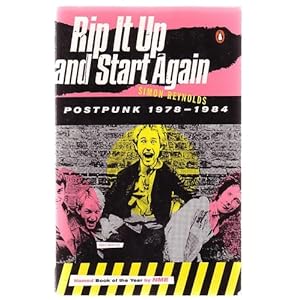
One day, I might figure out a way to write a "review" of something that doesn't have me expressing a quibble at such length that it overpowers and overwhelms my explanation that a book is otherwise good fun and you should read it. That said, Simon Reynolds either doesn't like the Cure - clearly one of the biggest and most influential of the postpunk acts that emerged during the period of 1978-1984 covered in his book Rip it Up and Start Again - or he figures they've been thoroughly covered at enough length by other writers and he didn't need to give 'em much mention here. I went into Rip it Up rather expecting them to be pretty key players, but they get about half a page in a pretty dismissive chapter about goth. He goes on for pages, and I mean pages, about The Pop Group, a band I had never in my life heard of, before mentioning that some of their members turned up in Rip Rig and Panic, a band that I've only ever known as those guys who were on that one episode of The Young Ones singing a song with incoherent lyrics. This isn't, clearly, a book to go into with expectations, because Reynolds is out to defy them.
Even while subverting expectations with every chapter, there is a lot of material here to absorb. England in the late seventies was an incredibly interesting place for new music. John Lydon's Public Image Limited bookends the first half of the narrative, with Malcolm McLaren's various weird and controversial projects weaving through. As kids throughout Great Britain became interested in reggae and dub, Tony Wilson started promoting Warsaw - slash - Joy Division, and synthesizers became inexpensive enough for every third twenty year-old in Sheffield to purchase one, record labels throughout the country - Virgin, Postcard, Factory - were releasing some really fun music.
Tasked with putting all of this into one flowing narrative, Reynolds somehow pulls it off. It seems like he's tied together dozens of disparate styles and movements from all around the country into a genuine and exciting theme of young musicians really trying something new, the desire for innovation in their individual schools being the theme that ties together acts that don't otherwise have anything in common. This feels like a really remarkable achievement when you consider that the American version, which I read, is something like 200 pages shorter than the original edition. Somebody pruned the absolute bejesus out of this book before issuing it here. I had no idea until I went searching for the link on Amazon and saw the outraged reviews.
(In one instance, it's to the book's benefit as far as I'm concerned. Lost to the American scissors is apparently a lengthy chapter on SST Records and industrial acts like Foetus and Test Department. Since I absolutely loathe that stuff, I find it no loss whatever. Errr, that is, I'm incredibly outraged on Reynolds' behalf. Yes. The American cover is depicted above, but clicking it takes you to an Amazon page where the UK edition is offered by sellers at a reasonable price.)
As the story winds its way throughout the day's new music - YouTube providing a fantastic soundtrack to groups unfamiliar or forgotten - it reaches a very surprising climax and conclusion with Frankie Goes to Hollywood, of all bands, wrapping up the story. Reynolds gets to Frankie by way of connections that would impress even James Burke, through McLaren, through The Lexicon of Love, through the Art of Noise and finally to that amazing, mountainous, world-changing, game-changing sound of "Relax." Recommended over my quibbles.
No comments:
Post a Comment